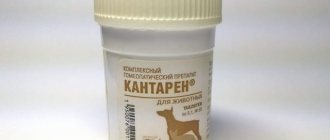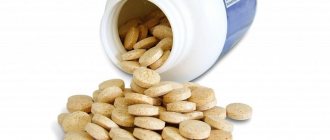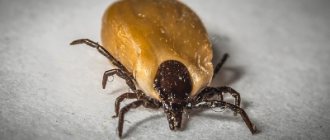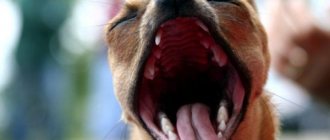Urolithiasis (UKD) in dogs is a fairly common disease that can cause significant harm to the health of your pet. It is difficult to diagnose it at an early stage, especially for a layman. The processes that take place in the animal’s body at the beginning of the formation of urolithiasis appear imperceptibly on the outside. That is why by the time the owner notices changes in the dog’s behavior, the disease has time to progress significantly. But there is good news: if you immediately contact a veterinary clinic, KSD can be treated!
General information about urolithiasis in dogs
Urolithiasis is the process of formation of sand and stones in the kidneys and bladder. Just like in humans, urolithiasis in dogs is accompanied by very painful sensations. The animal whines, takes strange poses and appears frightened during simple urination. If you suddenly notice changes in your pet’s behavior described above, then under no circumstances delay visiting the veterinarian. The dog is in a lot of pain, and it will get even worse later!
There are quite a few types of stones formed in the animal’s body. All of them consist of various microelements. There are also many reasons for the occurrence of ICD. Without understanding the causes of the disease and what type of stone we are dealing with at the moment, it is impossible to prescribe the correct treatment.
Stones in the urethra and bladder in a male dog
Main symptoms
The most common signs of the disease include the following:
- Frequent urination. The dog not only begins to ask to go out very often, but can also “make a puddle,” even if this is an adult animal and nothing like this has ever been noticed before.
- Pain during urine excretion. The dog squeals and whines while urinating, after which it takes a long time to come to his senses, does not want to play, run, tries to lie down and even hide away from people.
- The appearance of traces of blood, sand or pus in the urine if the disease is accompanied by an acute inflammatory process.
- Obstruction of the urinary tract, which can lead to intoxication and kidney failure.
- Signs of hepatic encephalopathy in dogs with portacaval shunts.
- The animal reacts painfully to touching the kidney part of the back and the lower half of the abdomen. In an acute condition, it can growl and can even bite the owner if he accidentally causes pain.
If the stones are in the kidneys or at the top of the ureters without blocking them, they can go undetected for a long time. The disease does not show itself in any way, and at this time chronic renal failure develops in dogs.
Causes of urolithiasis in dogs
In most cases, stones form directly in the animal's bladder. Much less often - in the kidneys. All the causes of the formation of urolithiasis, or, as it is also called, urolithiasis, are not fully known. But the main ones have long been proven:
- genetic predisposition. If your pet's parents had urolithiasis, there is a high probability that he himself will develop this disease;
- breed. Unfortunately, small breed dogs (dachshunds, pugs, hounds, bulldogs, etc.) are much more likely to be diagnosed with urolithiasis;
- congenital pathologies. Many factors in a dog’s body influence the formation of urolithiasis. Impaired metabolic processes, kidney disease, liver disease and even vascular disease can lead to the formation of urolithiasis;
- Almost any infection can lead to the formation of urolithiasis. Especially urinary tract infections;
From natural causes we move on to causes that arise as a result of incorrect content.
The first of them is an unbalanced diet. Very often, owners want to do what’s best: give their pet, who is used to eating dry food, a tasty morsel from their table. Or, conversely, due to lack of time, feed a dog that is accustomed to natural food with crackers from a bag. All this, as well as an excess of proteins and carbohydrates (you should not feed the dog only meat or cereals) are some of the main reasons for the formation of urolithiasis.
Besides:
- Don't make your dog endure it. Walk with her as often as possible! Urine that has been in the animal’s body for a long time begins to crystallize. That is, to turn into those same stones;
- Insufficient activity leads to obesity. And obesity leads to stagnation of fluid in the body, including urine;
- drink. Intermittent access to water, or drinking untreated tap water contributes to the formation of sand in the dog’s body. Keep track of what your pet drinks!
Features of diet selection
Dogs most often develop urolithiasis of the struvite type. The pathology is caused by struvite, which is also called tripelphosphate. Refers to soluble stones.
If tripel phosphates are detected in uric acid, food with acidifying properties is indicated. It contains a minimal amount of magnesium, which provokes the formation of struvite in the urinary apparatus.
Another type of stone found in dogs is oxalate stones. They are classified as insoluble uroliths. The diet for oxalate urolithiasis is aimed at preventing the formation of new stones due to its alkalizing effect.
Urates and cystines are much less common in veterinary practice. As a rule, they occur against the background of congenital diseases and genetic predisposition. Food from urates and cystines must have alkalizing properties.
Symptoms of urolithiasis in dogs
Urolithiasis in dogs, the symptoms and treatment of which can vary dramatically even between two puppies from the same litter, is further complicated by the fact that it is very difficult to detect its signs at an early stage. The urine becomes slightly cloudy and its quantity decreases slightly. By the time the dog begins to show obvious signs of discomfort and pain, the disease has progressed greatly. Remember: urolithiasis does not happen overnight! If your pet is examined and tested at a veterinary clinic at least once a year, you will prevent the development of the following symptoms:
- frequent urination. The dog pees a little at a time and cannot always wait until the next walk;
- the pet begins to lick the genitals frequently;
- the urine becomes very cloudy or takes on a pinkish or even dark red color. The presence of blood and sometimes pus in it is noticeable;
- lethargy, apathy, the dog begins to refuse food.
If the disease is completely neglected, blockage (obstruction) of the urinary tract occurs. This makes the symptoms even worse. The dog begins to pee a few drops at a time, experiencing very painful sensations. There is more and more blood in the urine, appetite worsens, and signs of anorexia appear.
As a result, the pet begins to vomit frequently, convulsions appear, the temperature rises, and the dog completely stops going to the toilet. At this stage of the disease, death is possible; the clock literally counts. You should consult a doctor immediately!
The role of bacterial infections
Bacterial infections of the bladder (that is, cystitis) play an important role in the formation of uroliths , and there are several explanations for this. Firstly, such diseases lead to an increase in the pH level and its movement into the alkaline zone. This can already cause excessive precipitation of salts called struvite when the animal consumes food with a low pH level. Normally, urine should have a neutral reaction, when the likelihood of developing a chemical reaction is reduced to zero.
But the presence of bacteria is dangerous not only for this. In particular, waste products of microorganisms themselves can precipitate, stimulating the development of uroliths. In addition, some bacteria synthesize an enzyme called urease. This compound, without going into the intricacies of organic chemistry, simply splits urine into its constituent components. Ammonia slowly turns into ammonium ions, while carbon dioxide combines with other components to form phosphates. Then, thanks to a chain of chemical reactions, magnesium, which is always present in the urine, combines with ammonium and phosphates. This is exactly how the same struvites are formed, which we already wrote about above.
Remember! The inflammatory reaction, which appears due to the action of pathogenic microflora, contributes to a sharp increase in the volume of mucous secretion. And, as we already know, it is an important “building” element of stones in the genitourinary system of an animal.
Diagnosis of urolithiasis in dogs
To diagnose urolithiasis in your pet, the doctor will first take fresh urine for analysis. It is very important that the waste product is collected immediately before the study. If the urine has time to sit and cool, crystals will begin to form. Essentially the same sand. This will lead to an incorrect diagnosis. A urine test will help determine not only the presence of the disease, but also the type of stones. Let us remind you that the treatment tactics for urolithiasis in dogs depend on the type of stones. Different stones are treated differently. You cannot prescribe a course of tablets or injections without making sure which stone you are treating. A panacea for one can accelerate the growth of another urolith.
Next, in order to understand exactly where the stone is located, what size it is, and also to assess the general condition of the body, the doctor will do an ultrasound and possibly an x-ray. In addition, a biochemical blood test may be necessary to make a diagnosis.
Stones in a dog's bladder
Remember: only after the doctor has collected a complete history, asked about the symptoms, and conducted the necessary research, can he correctly prescribe a course of treatment. Otherwise, if the disease has not been studied thoroughly, treatment will turn into Russian roulette. Whether you're lucky or unlucky.
Dog Bladder Stones
Veterinary clinic of Dr. Shubin
Description and reasons
Urolithiasis (urolithiasis) in dogs is a phenomenon of the formation and presence of uroliths in the urinary tract (kidneys, ureters, bladder and urethra).
Uroliths (uro – urine, lith – stone) are organized stones consisting of minerals (primarily) and a small amount of organic matrix. There are three main theories of the formation of urinary stones: 1. Precipitation-crystallization theory; 2. Matrix-nucleation theory; 3. Crystallization–inhibition theory. According to the first theory, oversaturation of urine with one or another type of crystals is put forward as the main reason for the formation of stones and, consequently, urolithiasis. In the theory of matrix nucleation, the presence of various substances in the urine that initiate the onset of urolith growth is considered as the reason for the formation of uroliths. In the theory of crystallization-inhibition, it is assumed that there are factors in the urine that inhibit or provoke the formation of stones. Oversaturation of urine with salts in dogs is considered to be the main cause of urolithiasis; other factors play a less significant role, but can also contribute to the pathogenesis of stone formation.
Most canine uroliths are identified in the bladder or urethra. The predominant type of urinary stones are struvite and oxalate, followed by urate, silicate, cystine and mixed types in frequency of occurrence. The last twenty years have seen an increased percentage of oxalates, presumably this phenomenon developed due to the widespread use of industrial feed. An important cause of struvite formation in dogs is urinary tract infection. Below are the main factors that can increase the risk of dogs developing one or another type of urolithiasis.
Risk factors for the development of urolithiasis in dogs with the formation of oxalates
Oxalate urinary stones are the most common type of uroliths in dogs; the incidence of urolithiasis with this type of stones has increased significantly over the past twenty years, along with a decrease in the incidence of struvite-predominant stones. Calcium oxalate urinary stones contain calcium oxalate monohydrate or dihydrate, and the outer surface usually has sharp, jagged edges. From one to many uroliths can form, the formation of oxalates is characteristic of acidic dog urine.
Possible reasons for the increased incidence of oxalate uroliths in dogs include demographic and dietary changes in dogs that have occurred during this period. These factors may include feeding an acidifying diet (widespread use of industrial feeds), an increase in the incidence of obesity and an increase in the percentage of breeds prone to the formation of a certain type of stone.
A breed predisposition to urolithiasis with the formation of oxalates has been noted in representatives of such breeds as the Yorkshire Terrier, Shih Tzu, Miniature Poodle, Bichon Frize, Miniature Schnauzer, Pomeranian, Cairn Terrier, Maltese and Kesshund. Gender predisposition has also been noted in castrated males of small breeds. Urolithiasis due to the formation of oxalate stones is more often observed in middle-aged and elderly animals (average age 8-9 years).
In general, the formation of uroliths is more related to the acid-base balance of the animal's body than to the specific pH and composition of urine. Dogs with oxalate urolithiasis often exhibit transient hypercalcemia and hypercalciuria after feeding. Thus, uroliths can form against the background of hypercalcemia and the use of calciuretics (eg furosemide, prednisolone). Unlike struvite, urinary tract infection with oxalate uroliths develops as a complication of urolithiasis, and not as the root cause. Also, with the oxalate form of urolithiasis in dogs, there is a high percentage of relapse after stone removal (about 25%-48%).
Risk factors for the development of urolithiasis in dogs with struvite formation
According to some data, the percentage of struvite urolithiasis to the total number is 40%-50%, but in recent years there has been a significant decrease in the incidence of struvite urolithiasis in favor of oxalate urolithiasis (see above). Struvite consists of ammonium, magnesium and phosphate ions, the shape is rounded (spherical, ellipsoidal and tetrahedral), the surface is often smooth. With struvite urolithiasis, both single and multiple uroliths with different diameters can form. Struvite in the canine urinary tract is most often located in the bladder, but can also occur in the kidneys and ureter.
The vast majority of canine struvite urinary stones are induced by a urinary tract infection (most commonly Staphylococcus intermedius, but Proteus mirabilis may also play a role). Bacteria have the ability to hydrolyze urea to ammonia and carbon dioxide, this is accompanied by an increase in urine pH and contributes to the formation of struvite urinary stones. In rare cases, dog urine can be oversaturated with the minerals that make up struvite, and then urolithiasis develops without the involvement of infection. Based on the possible causes of struvite urolithiasis in dogs, even with a negative urine culture, the search for infection continues and it is preferable to culture the bladder wall and/or stone.
With urolithiasis in dogs with the formation of struvite uroliths, a breed predisposition has been noted in such representatives as the miniature schnauzer, bichon frise, cocker spaniel, shitzu, miniature poodle and Lhasa apso. Age predisposition was noted in middle-aged animals, and gender predisposition in females (presumably due to an increased incidence of urinary tract infections). The American Cocker Spaniel may have a predisposition to form sterile struvites.
Risk factors for the development of urolithiasis in dogs with the formation of urates
Urate urinary stones account for about a quarter (25%) of all stones delivered to specialized veterinary laboratories. Urate stones consist of a monobasic ammonium salt of uric acid, are small in size, their shape is spherical, the surface is smooth, the multiplicity of urolithiasis is characteristic, the color ranges from light yellow to brown (maybe green). Urate stones usually crumble easily, and concentric layering is visible on the fracture. With urate urolithiasis, a certain predisposition to urolithiasis has been noted in male dogs, presumably due to the smaller lumen of the urethra. Also, with urolithiasis in dogs with the formation of urates, a high percentage of relapses after stone removal is characteristic, it can be 30%-50%.
Unlike representatives of other breeds, the Dalmatian has a violation of purine metabolism, which leads to the release of increased amounts of uric acid and a predisposition to the formation of urates. It should be remembered that not all Dalmatians develop urates, despite the congenital elevated level of uric acid in the animal’s urine; a clinically significant disease is detected in animals in 26%-34% of cases. Some other breeds (English Bulldog and Black Russian Terrier) may also have a hereditary predisposition to impaired purine metabolism (similar to Dalmatians) and a tendency to the urate form of urolithiasis.
Another reason for the formation of urates is a portosystemic shunt and microvascular dysplasia of the liver, which disrupts the conversion of ammonia to urea and uric acid to allantoin. With the above disorders of the liver, a mixed form of urolithiasis is more often observed; in addition to urates, struvite is also formed. A breed predisposition to the formation of this type of urolithiasis has been noted in breeds predisposed to the formation of portosystemic liver shunts (example Yorkshire terrier, miniature schnauzer, Pekingese).
Risk factors for the development of urolithiasis in dogs with the formation of silicate stones
Silicate uroliths are also rare and cause urolithiasis in dogs (about 6.6% of the total number of urinary stones), they consist mostly of silicon dioxide (quartz), and may contain small amounts of other minerals. The color of silicate urinary stones in dogs is gray-white or brownish, and multiple uroliths are more often formed. A predisposition to the formation of silicate stones has been noted in dogs fed a diet high in gluten grains (gluten) or soybean skins. The relapse rate after stone removal is quite low. As with oxalate urolithiasis, urinary tract infection is considered a complicating rather than a causative factor in the disease.
Risk factors for the development of urolithiasis in dogs with the formation of cystine
Cystine uroliths are rare in dogs (about 1.3% of the total number of urinary stones), they consist entirely of cystine, they are small in size, spherical in shape. The color of cystine stones is light yellow, brown or green. The presence of cystine in the urine (cystinuria) is considered a hereditary pathology with impaired transport of cystine in the kidneys (± amino acids), the presence of cystine crystals in the urine is regarded as a pathology, but not all dogs with cystinuria form the corresponding urinary stones.
A number of dog breeds have been shown to have a breed predisposition to the disease, such as the English Mastiff, Newfoundland, English Bulldog, Dachshund, Tibetan Spaniel and Basset Hound. Cystine urolithiasis in dogs has an exclusive gender predisposition in males, with the exception of the Newfoundland. The average age of onset of the disease is 4-6 years. When removing stones, a very high percentage of relapses of their formation was noted, it is about 47%–75%. As with oxalate urolithiasis, urinary tract infection is considered a complicating rather than a causative factor in the disease.
Risk factors for the development of urolithiasis in dogs with the formation of hydroxyapatite (calcium phosphate)
This type of urolith is extremely rarely observed in dogs, and apatite (calcium phosphate or calcium hydroxyl phosphate) often acts as a component of other urinary stones (usually struvite). Alkaline urine and hyperparathyroidism predispose to precipitation of hypoxyapatitis in the urine. The following breeds have been shown to be predisposed to the formation of this type of urinary stones: Miniature Schnauzer, Bichon Frize, Shih Tzu and Yorkshire Terrier.
Clinical signs
Struvite urinary stones are more often found in females, due to their increased susceptibility to urinary tract infections, however; clinically significant urethral obstruction is more common in male dogs due to the narrower and longer urethra. Urolithiasis in dogs can occur at any age, but is more common in middle-aged and elderly animals. Urinary stones in dogs under 1 year of age are most often struvite and develop due to a urinary tract infection. With the development of the oxalate form of urolithiasis in dogs, the development of stones is more often observed in males, especially in breeds such as miniature schnauzer, Shitzu, Pomeranian, Yorkshire terrier and Maltese. Also, oxalate urolithiasis in dogs is observed at an older age compared to the struvite type of urolithiasis. Urates are more often formed in Dalmatians and English bulldogs, as well as in dogs predisposed to the development of portosystemic shunt. Cystine uroliths also have a certain breed predisposition; the table below contains general information on the incidence of urolithiasis in dogs.
Table. Breed, gender and age predisposition for the formation of urinary stones in dogs.
| Type of stones | Morbidity |
| Struvite | Breed Predisposition: Miniature Schnatsuer, Bichon Frize, Cocker Spaniel, Shih Tzu, Miniature Poodle, Lhasa Apso. Sexual predisposition in females Age predisposition – middle age The main predisposing factor to the development of struvite is infection of the urinary tract with urease-producing bacteria (eg Proteus, Staphylococcus). |
| Oxalates | Breed Predisposition – Miniature Schnauzer, Shih Tzu, Pomeranian, Yorkshire Terrier, Maltese, Lhasa Apso, Bichon Frize, Cairn Terrier, Miniature Poodle Sexual predisposition – more often in castrated males than in non-castrated males. Age predisposition: middle and old age. One of the predisposing factors is obesity |
| Urats | Breed predisposition – Dalmatian and English bulldog The main factor predisposing to the development of urates is a portosystemic shunt, and accordingly it is more often observed in predisposed breeds (eg Yorkshire Terrier, Miniature Schnauzer, Pekingese) |
| Silicates | Breed predisposition – German Shepherd, Old English Sheepdog Gender and age predisposition – middle-aged males |
| Cystines | Breed Predisposition – Dachshund, Basset Hound, English Bulldog, Newfoundland, Chihuahua, Miniature Pinscher, Welsh Corgi, Mastiffs, Australian Cowdog Gender and age predisposition – middle-aged males |
| Calcium phosphate | Breed predisposition – Yorkshire Terrier |
The history of canine urolithiasis depends on the specific location of the stone, the duration of its presence, various complications and diseases predisposing to the development of the stone (eg portosystemic shunt).
When urinary stones are found in the kidneys, animals are characterized by a long asymptomatic course of urolithiasis; there may be blood in the urine (hematuria) and signs of pain in the kidney area. With the development of pyelonephritis, the animal may experience fever, polydipsia/polyuria and general depression. Ureteral stones are rarely diagnosed in dogs, dogs may present with various signs of lumbar pain, most animals are more likely to develop a unilateral lesion without systemic involvement, and the stone may be discovered as an incidental finding in the setting of renal hydronephrosis.
Canine bladder stones represent the vast majority of cases of urolithiasis in dogs; the owner's complaint when contacting a veterinary clinic may be signs of difficulty and frequent urination, and sometimes hematuria occurs. The displacement of stones into the urethra of male dogs can lead to partial or complete obstruction of the outflow of urine, in which case the primary complaints may be signs of strangury, abdominal pain and signs of postrenal renal failure (eg anorexia, vomiting, depression). In rare cases of complete obstruction of urine outflow, complete rupture of the bladder with signs of uroabdomen may develop. It should be remembered that urinary tract stones in dogs can be asymptomatic and are detected as an incidental finding during plain radiographic examination.
Physical examination data for urolithiasis suffer from poor specificity of symptoms. With unilateral hydronephrosis in dogs, an enlarged kidney (renomegaly) may be detected during palpation examination. With obstruction of the ureters or urethra, pain in the abdominal cavity can be determined; with rupture of the urinary tract, signs of the uroabdomen and general depression develop. During a physical examination, bladder stones can be detected only if they are of a significant number or volume; upon palpation, the sounds of crepitus can be detected or a urolith of significant size can be palpated. With obstruction of the urethra, palpation of the abdomen can reveal an enlarged bladder, rectal palpation can reveal a stone localized in the pelvic urethra, and if the stone is localized in the urethra of the penis, in some cases it can be palpated. When attempting to catheterize the bladder of an animal with urethral obstruction, a veterinary clinician may identify mechanical resistance to the catheter.
The most radiopaque urinary stones are uroliths containing calcium (calcium oxalates and phosphates); struvites are also well identified by plain radiographic examination. The size and number of radiopaque stones is best determined by X-ray examination. Double contrast cystography and/or retrograde urethrography can be used to identify radiolucent stones. Ultrasound diagnostic methods can detect radiolucent stones in the ureter of the bladder and urethra, in addition, ultrasound can help in assessing the kidneys and ureter of the animal. When examining a dog with urolithiasis, radiographic and ultrasound methods are usually used together, but, according to many authors, double contrast cystography is the most sensitive method for identifying bladder stones.
Laboratory tests for a dog with urolithiasis include a complete blood count, a biochemical profile of the animal, a complete urinalysis, and a urine culture. With canine urolithiasis, even in the absence of obvious urinary tract infection, hematuria and proteinuria, there is still a high probability of urinary tract infection, and it is preferable to use additional research methods (eg urine cytology, urine culture). A biochemical blood test can detect signs of liver failure (eg, high blood urea nitrogen, hypoalbuminemia) in dogs with a portacaval shunt.
Diagnosis and differential diagnosis
Urinary stones should be suspected in all dogs with signs of urinary tract infection (eg hematuria, stranguria, pollakiuria, urinary obstruction). The list of differential diagnoses includes any form of bladder inflammation, urinary tract neoplasms, and granulomatous inflammation. Detection of uroliths as such is carried out through visual examination methods (radiography, ultrasound), in rare cases, identification of uroliths is possible only intraoperatively. Determining the specific type of urolith requires its examination in a specialized veterinary laboratory.
It should be remembered that the identification of most crystals in urine does not always indicate pathology (with the exception of cystine crystals); in many dogs with urolithiasis, the type of crystals found in the urine may differ in composition from urinary stones; crystals may not be detected at all, or multiple crystals may be detected without the risk of urinary stone formation.
Treatment
The presence of urinary stones in the urinary tract of dogs is not always associated with the development of clinical signs; in many cases, the presence of uroliths is not accompanied by any symptoms on the part of the animal. In the presence of uroliths, several scenarios may occur: their asymptomatic presence; evacuation of small uroliths into the spring environment through the urethra; spontaneous dissolution of urinary stones; growth cessation or continuation; addition of a secondary urinary tract infection (bacterial cystitis or pyelonephritis); partial or complete obstruction of the ureter or urethra (if the ureter is blocked, unilateral hydronephrosis may develop); formation of polypoid inflammation of the bladder. The approach to a dog with urolithiasis largely depends on the manifestation of certain clinical signs.
Urethral obstruction is an emergency, and if it develops, a number of conservative measures can be taken to displace the stone either outward or back into the bladder. In females, rectal palpation with massage of the urethra and urolith towards the vagina can promote its exit from the urinary tract. In both females and males, the urethrohydropuslation method can push the urinary stone back into the bladder and restore normal urine flow. In some cases, when the diameter of the urolith is smaller than the diameter of the urethra, descending urohydropulsion can be used, when a sterile saline solution is injected into the bladder of an animal under anesthesia, followed by manual emptying in an attempt to remove stones (the procedure can be performed several times).
Once the stone has been displaced into the bladder, it can be removed by cytostomy, endoscopic laser lithotripsy, endoscopic basket extraction, laparoscopic cystotomy, dissolved by drug therapy, or destroyed by extracorporeal shock wave lithotripsy. The choice of method depends on the size of the animal, the equipping of the veterinary clinic with the necessary equipment and the qualifications of the veterinarian. If it is impossible to move the stone from the urethra, urethrotomy can be used in male dogs, followed by removal of the stone.
Indications for surgical treatment of urolithiasis in dogs include such indicators as obstruction of the urethra and ureter; multiple recurrent episodes of urolithiasis; lack of effect from attempts to conservatively dissolve stones within 4-6 weeks, as well as the personal preferences of the doctor. When localizing uroliths in the kidneys of dogs, pyelotomy or nephrotomy can be used; it should be remembered that in dogs, uroliths of the kidneys and bladder can also be crushed using extracorporeal shock wave lithotripsy. If urinary stones are found in the ureters and localized in the proximal areas, ureteretomy can be used; if they are localized in the distal parts, resection of the ureter can be used, followed by the creation of a new connection with the bladder (ureteroneocystostomy).
Indications for conservative treatment of urolithiasis in dogs are the presence of soluble uroliths (struvite, urate, cystine and maybe xanthine) as well as animals with concomitant diseases that increase the surgical risk. Regardless of the composition of the urolith, general measures are taken in the form of increased water consumption (and therefore increased diuresis), treatment of any underlying diseases (ex. Cushing's disease) as well as treatment of bacterial urinary tract infections (primary or secondary). It should be remembered that bacterial infection (cystitis or pyelonephritis) makes a significant contribution to the development of urolithiasis in dogs, either as a trigger or as a maintaining mechanism. The effectiveness of conservative dissolution of canine urinary stones is usually monitored by visual examination (usually x-ray).
With struvite urolithiasis, the main reason for their formation in dogs is a urinary tract infection, and they dissolve with adequate antibacterial therapy, possibly with the combined use of dietary feeding. At the same time, the average time for dissolution of infected uroliths in dogs during treatment is about 12 weeks. With the sterile form of struvite urolithiasis in dogs, the time required for the dissolution of urinary stones is much shorter and takes about 4-6 weeks. In dogs with struvite urolithiasis, a change in diet may not be necessary to dissolve stones; reverse development of stones is observed only against the background of appropriate antibacterial therapy and increased water consumption.
In dogs with urate form of urolithiasis, in an attempt to conservatively dissolve stones, allopurinol can be used at a dose of 10-15 mg/kg PO x 2 times a day, as well as alkalinization of urine by changing the diet. The effectiveness of conservative dissolution of urates is less than 50% and takes an average of 4 weeks. It should be remembered that a significant cause of urate formation in dogs is a portosystemic shunt, and dissolution of stones can be observed only after surgical resolution of this problem.
For cystine uroliths in dogs, 2-mercatopropionol glysine (2-MPG) 15-20 mg/kg PO x 2 times a day can be used in an attempt to conservatively treat urolithiasis, as well as feeding an alkalizing diet low in protein. The dissolution time for cystine stones in dogs takes about 4-12 weeks.
Xanthine uroliths are treated by reducing the dose of allopurinol and a low-purine diet; there is a possibility of their reverse development. With oxalate uroliths, there are no proven methods for their dissolution and it is generally accepted that they cannot be reversed despite all the measures taken.
Valery Shubin, veterinarian, Balakovo
Treatment of urolithiasis in dogs
Treatment of urolithiasis in dogs, regardless of the type of stones, should first begin with the removal of stagnant urine. This will make your pet's condition a little easier. After your dog's bladder has been emptied, your doctor will tell you what to do next.
Depending on how far urolithiasis has developed in dogs, the treatment of the disease will be radically different. For some, it is enough to go on a diet, while others will have to resort to surgery. And again: any appointments will depend on the type of stones. Even the diet, as you understand, for removing alkaline formations and uroliths that have arisen in an acidic environment will be significantly different.
As a rule, urolithiasis in dogs is treated with traditional methods: the urinary tract is washed, a course of medications is prescribed, and a strict diet is prescribed. If the disease is advanced, surgical intervention will be required before carrying out therapeutic measures. From time to time, doctors may resort to non-standard methods of influence. But remember: if the doctor insists on surgery, then it is really necessary! Don't risk your pet's life! Self-medication has never brought any good to either people or dogs.
Treatment methods
Further therapy depends on the form of the disease and the type of stones. Sometimes a simple change in diet is enough to help your pet recover, and sometimes the only solution is emergency surgery.
Despite the variability of possible solutions, in all cases the primary task is to remove accumulated urine by cleansing the urinary ducts. On average, the process of destruction of urinary stones is 1-4 months.
Catheterization
In case of anuria, the animal is given a catheter to drain urine and wash the ducts. The procedure is performed under general anesthesia. Catheterization allows you to create back pressure inside the urethra, which helps push the formed stones back into the bladder, bypassing the operation.
Also, insertion of a catheter may be necessary if renal failure is detected. In this case, the four-legged patient needs blood purification. For this purpose, hemodialysis is performed.
Removing Stones
If catheterization and drug therapy do not give the desired effect, then the outflow of urine is quickly restored. For this purpose, several operation options are used:
- Cystostomy
. The surgeon cuts the bladder at the site where the stones are deposited and removes them out. Before the stitches heal, the pet urinates through the catheter. The disadvantage of this operation is the high probability of narrowing of the ducts and their re-clogging.
- Urethrostomy
. This operation involves widening the natural opening in the urethra. To prevent its overgrowth, mandatory castration is recommended for all male dogs.
- Retrograde urohydropulsion
. The stones are pushed back into the bladder, where they are removed using a cystostomy.
Some formations are amenable to pulsed magnetic therapy. This procedure is based on a low-frequency magnetic field that breaks stones into smaller pieces. In this case, they leave the body on their own.
Drug therapy
If a secondary infection or inflammatory process is detected, the pet is prescribed antibiotics. Together with them, it is recommended to take hepatoprotectors, probiotics and immunomodulators. These drugs help relieve the load on the liver, normalize intestinal function and restore the body's defenses.
For severe pain, antispasmodics and painkillers are prescribed: Papaverine, Baralgin and No-Shpu. For acute pain, novocaine blockade is recommended.
Urine concentration is reduced with diuretics. They increase its rate of formation, stimulating the removal of stones and preventing the deposition of new ones. It is also recommended to use herbal infusions and mineral water.
Prevention of urolithiasis in dogs
Prevention of urolithiasis in dogs, first of all, consists of proper care. If your pet has already had urolithiasis, strictly follow the instructions and prescriptions issued by your veterinarian.
If the animal is healthy, remember a few simple rules that will reduce the likelihood of urolithiasis to a minimum:
- feed your dog correctly: either only dry food, which is selected specifically for your pet, or only natural food. Remember: you cannot mix dry and natural food. Even in small quantities! And, most importantly, the dog’s food should include all the necessary minerals and beneficial elements;
- Eliminate raw tap water from your dog's diet. Give your pet either boiled or filtered. And make sure that there is always water in the bowl, especially in the warm season. In summer it is also worth taking a drink with you on walks. Are you thirsty in the heat? Your pet too;
- Walk your dog more often. Spend at least two hours walking a day. Try to get your dog to go outside at least once a day.
- Run, play, watch the physical development of your tailed friend! Do not let your dog lie in one place for days;
- Provide your pet with its own place. Lying on a cold floor is harmful. This also leads to the formation of ICD;
- Get tested at a veterinary clinic at least once a year. Especially if the animal is at risk. Remember: the earlier you detect the disease, the easier your dog will tolerate treatment. The pet will not be in excruciating pain, surgery will be avoided, and the family budget will remain much safer. Yes, prevention is always better than treatment for an advanced disease!
Which breeds are more susceptible
Different breeds tend to develop different types of urinary stones:
- Struvite stones, while most common, occur in middle-aged dogs (4–6 years old). Miniature schnauzers, beagles, Scotch terriers, dachshunds, poodles and Pekingese are more susceptible to the formation of this type of stones. It is interesting that stones of this type occur more often in females than in males, they are accompanied by infection, and the urine has an alkaline reaction.
- Oxalate stones are more likely to form in older dogs - 7-8 years old, more often in males than in females. The most susceptible are miniature schnauzers, Yorkshire terriers, “chrysanthemum dogs” Shih Tzu, and Lhasa Apso. The inflammatory process is rare, the urine reaction is acidic.
- Urate stones most often plague Dalmatians suffering from a genetic disorder of purine metabolism. Young animals get sick, but in principle they can be of any age. Young dogs with portal blood flow disorders - miniature schnauzers, Irish wolfhounds, Yorkshire terriers, Maltese dogs, Australian shepherds and Cairn terriers - under 12 months of age are also prone to urate formation. Males with acidic urine are more susceptible to the disease.
- Cystine stones occur with cystinuria; stone formation is not always observed; males aged 1.5 to 5 years are affected. At risk are Chihuahuas, English bulldogs, Irish terriers, dachshunds, and Yorkshire terriers. The urine reaction is most often acidic.
It cannot be said that there are dog breeds that are not prone to developing urolithiasis. It can appear in certain circumstances in dogs of any breed and age.
Nutrition for dogs with urolithiasis
What to feed a dog with urolithiasis? Your veterinarian will tell you about this. Let us remind you that with different types of uroliths formed in the body, the diet for dogs with urolithiasis will differ significantly. Different animals require different minerals and trace elements for successful recovery. Most manufacturers produce medicinal dog food for urolithiasis. Your doctor will explain in detail what kind of food your pet should eat and why. Natural nutrition for urolithiasis in dogs is also prescribed by a veterinarian. The diet should consist of different foods - porridge, meat, vegetables. Fatty, fried, sweet and salty foods are completely excluded from the animal's diet. Do you want to extend the life of your pet? Do you want to make sure that the disease does not return? Strictly monitor your dog's diet!
Prognosis for urolithiasis in dogs
In most cases, urolithiasis in dogs is not treated, but stopped. This should be remembered first of all by owners who have seen the effect of treatment. No, nothing is over! Very often, people who notice that their pet is feeling better stop following the diet and taking medications. Don’t even think about doing this: refusing treatment will return all the symptoms and excruciating pain to your dog in a matter of weeks!
In general, the prognosis is favorable. But only with strict adherence to the instructions, otherwise a relapse cannot be avoided. Follow a diet, walk more, take medications strictly according to instructions and periodically get tested at a veterinary clinic, then the life of your beloved dog will be long, happy, and illnesses will pass and be forgotten!
What to do at home
Treatment of urolithiasis is long and quite complex. If an animal is scheduled for surgery, it will be under observation in the clinic for the first time. When the veterinarians are sure that everything is fine with the dog, she will be released home. At home, the animal is provided with complete rest, warmth, proper nutrition, following a special diet prescribed by a veterinarian for a specific type of stone.
If there is an inflammatory process or in the postoperative period, the dog is prescribed a course of antibiotic therapy. Treatment of the disease is long-term, up to several months, and in case of chronic urolithiasis with kidney damage - lifelong.
After bougienage, ultrasonic crushing of stones or surgery, the animal must be regularly brought for checks to the veterinary clinic in order to ensure positive results of treatment and prevent relapse of the disease.
At home, the most important thing for a dog is diet and sufficient, but not excessive, clean drinking water, as well as protection from hypothermia and infections.
If struvite is present, diets restricting protein, calcium, magnesium and phosphorus are used. With urates, the amount of proteins and purines in food is reduced. Cystine stones also reduce the volume of proteins. Oxalate stones require the elimination of hypercalcemia if the veterinarian has concluded that such a problem exists.
Clinical case of treatment of acute urinary retention with urinary tract disease in dogs
A Scottish Terrier dog named Vicky was admitted in emergency condition with acute urinary retention. Based on the results of diagnostic tests and examination by a veterinarian, a diagnosis was made: acute urinary retention due to blockage of the urethra by stones with a diameter of 10 mm. Doctor Andrey Konstantinovich Mamedkuliev decided to prescribe surgical treatment with further cystotomy and removal of stones from the urethra. During the operation, stones were removed and the urethra and bladder were washed.
The treatment and surgery were successful. Now Vicky can empty her bladder freely and not experience any pain.
Establishing diagnosis
If copious amounts of blood are discharged or anuria occurs, go to the veterinary clinic without an appointment. Due to the high probability of death, doctors at a 24-hour facility are required to provide emergency care at any time of the day.
To make a diagnosis, urine and blood tests are taken from the four-legged patient. Due to stagnation of fluid, urine is collected directly on the spot by puncturing the bladder. The type of stones is determined by ultrasound and x-ray. A blood culture test is also performed to exclude or confirm the presence of a secondary infection.











